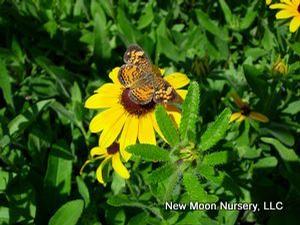New Moon Nurseries
Rudbeckia hirta
Sweet black-eyed Susan
Native to North America
FIRST IMPRESSIONS: Rudbeckia hirta is an adaptable wildflower with flexible lance shaped leaves. Plants are topped by showy terminal daisy-like flowers in summer. The blooms are 2-3” across with bright yellow rays surrounding a dense chocolate brown cone. This trooper is content in prairie-like settings, disturbed fields and sunny gardens with averages soil.
HABITAT & HARDINESS: Rudbeckia hirta occurs through the southern Canadian provinces and in all the contiguous United States except for Nevada and Arizona.
Indigenous plants are found in mesic to dry prairies, savannas, limestone glades, upland woodlands and open rocky woods. This species successfully colonizes disturbed sites like pastures, old fields, roadsides right-of-ways and eroded clay banks.
Plants are hardy from USDA Zones 3-9.
PLANT DESCRIPTION: Rudbeckia hirta is an annual, biennial or short lived perennial wildflower. Plants produce several stems that emerge from a crown and taproot. Since they have no rhizomes this species colonizes or spreads by seed.
Lower and mid stems are clad in grayish green pubescent oval or lance shaped blades. The leaves are up to 7” long and 2” across. They have smooth or ciliate margins and occasionally a few blunt teeth. The petioles on the basal leaves are long and hairy and those of the upper leaves are very short or absent.
The upper stems are leafless and each stem or branch bears one terminal composite flower. Each flower has a short dense cone loaded with small disc florets and wreathed by 8-20 golden ray florets. The rays are occasionally marked with maroon at the base.
The daisy-like flowers are 2-3” across for about a month in early or mid-summer. The cone matures into a persistent dark brown seed cluster.
Plants grow 2-3’ tall with 1-2’ spread.
CULTURAL & MAINTENANCE NEEDS: Rudbeckia hirta is easily cultivated in sunny sites with moist, average or dry soils. Plants tolerate part sun, heat, controlled burns, sand or clay.
This species is considered to be among the most drought tolerant Rudbeckia spp. Plants are fairly pest resistant except for occasional mild bouts of powdery mildew.
Rudbeckia hirta is fairly short lived but reliably self-sows especially in open soil. In good cultural situations, seedlings will bloom the first year.
LANDSCAPE USES: Rudbeckia hirta is a great choice for a Prairie or Meadow Garden where it can be used as an Accent, Butterfly Nectar Plant or as part of a Grouping or Mass. This Black-eyed Susan offers Showy Blooms and is appropriate for Cottage Gardens, Deer Resistant Plantings, Water-wise Landscapes, Low Maintenance Plantings, Perennial Borders, Roadsides, Restoration Projects and Wildlife Gardens.
COMPANION & UNDERSTUDY PLANTS: Rudbeckia hirta mingles well with Asclepias tuberosa, Asclepias verticillata, Coreopsis tripteris, Echinacea purpurea, Liatris aspera, Sorghastrum nutans and Sporobolus heterolepis.
In dry sites, Rudbeckia triloba would offer similar appearance and provide the same quick effect.
TRIVIA: Rudbeckia hirta is Maryland’s State Flower.
Blossoms attract native bees, pollinating flies, beneficial wasps and butterflies.
Caterpillars of Silvery Checkerspot Butterflies forage on the foliage and seeds are consumed by goldfinches. Foliage is not particularly palatable to deer and other herbivores.
The gloriosa daisies grown in ornamental gardens are tetraploid forms of Rudbeckia hirta. The first gloriosas originated when R. hirta seed was treated with colchicine. Gloriosa daisies have very large flowers that are often double with colorful markings.
Height:
2-3 ftSpread:
1-2 ftSpacing:
2 ftUSDA Hardiness Zone:
3-9Bloom Color:
YellowRudbeckia hirta Characteristics
Attracts Wildlife
- Butterflies
- Songbirds
- Pollinators
Attributes
- Drought Tolerant
- Dried Flower
- Cut Flower
- Rock Garden
- Clay Soil
- Naturalizing
- Long Blooming
- East-Coast Native
Exposure
- Full Sun to Partial Shade
Deer Resistant
- Deer Resistant
Flowering Months
- September
- August
- July
Foliage Color
- Green
Growth Rate
- Medium
Juglans nigra Tolerance (Black Walnut)
- Yes
Salt Tolerance
- Medium
Season of Interest (Foliage)
- Spring
- Fall
- Summer
Soil Moisture Preference
- Moist to Dry
Interesting Notes:
For more information on this plant, visit the USDA PLANTS Database: http://plants.usda.gov/java/profile?symbol=RUHI2
